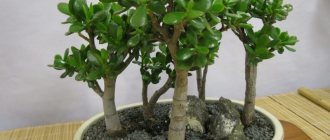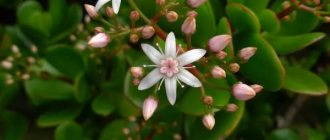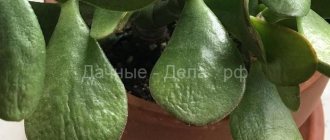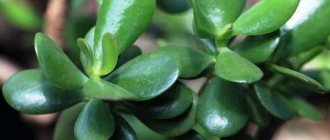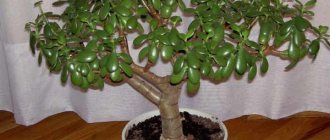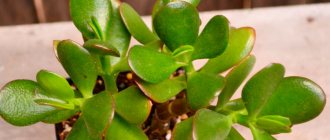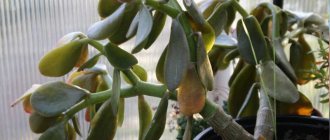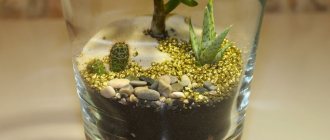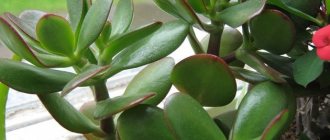Why do the leaves become limp and fall off?
In addition to the main reasons for the loss of leaves on the money tree described above, there are several more that are directly related to the characteristics of caring for the plant at different times of the year.
In summer, the money tree must be protected from the scorching sun, drying out of the soil and too dry air, drafts and overheating of the substrate in the pot. It should be watered daily, moderately, in the evening, removing excess moisture from the pan.
In the fall, it is important to bring the money tree indoors in time. Night cold temperatures below 10ºC can cause hypothermia of the root system, which can cause disease or stress
In winter, you should not place a money tree near heating appliances. In the short days of late autumn and until mid-winter, the plant needs additional lighting. The optimal length of daylight for a money tree is 10-12 hours; based on this condition, it is provided with additional lighting.
Another winter problem is dry indoor air. Although the fat woman is indifferent to humidity, once a month she will benefit from a small warm shower.
There are a number of other problems that lead to the leaves of the fat plant falling off, but they relate to the plant’s habitat.
Money tree is an energetically powerful plant. It is strongly connected with its owners, often falling ill with them. Therefore, it often happens that the tree begins to wither if one of the household becomes seriously ill.
If the money tree is kept under normal conditions and its care is carried out “according to the textbook,” experienced flower growers advise paying the owners’ attention to their own health. Often, exacerbations of chronic diseases of family members have a negative impact on the plant: it grows poorly, the leaves wither and fall off
Here it is not the plant that needs to be treated, but people. With the recovery of the owners, the money tree quickly comes to its senses
Often, exacerbations of chronic diseases of family members have a negative impact on the plant: it grows poorly, the leaves wither and fall off. Here it is not the plant that needs to be treated, but people. With the recovery of the owners, the money tree quickly comes to its senses.
Also, the energetic connection between the fat woman and family members is clearly expressed when conflict situations arise. If quarrels, scandals, and conflict situations often occur in the house, the money tree, like a tender young lady, begins to mope, expressing its protest by dropping leaves. And in this case, it is not the plant that needs help, but people. When home calm and peace are restored, the tree will also be restored.
Causes of the problem
She herself signals her problems to her owners. It's important to be careful. This is primarily manifested by the condition of the foliage. If leaves begin to fall, then it is worth taking action. The first sign of trouble may be the money tree's leaves becoming soft and then dropping.
Most often, leaves fall off due to extreme heat or excessive watering. The tree does not really like wet soil. The soil should be slightly moistened, so in summer, despite the heat, you should not get carried away with watering. It will be enough to carry it out after 2-3 days. But it is best to focus on the condition of the soil.
During the heating season, leaf fall can be caused by a lack of air humidity. Always in winter, the plant slows down its growth, fewer fresh leaves appear on it. They don't grow much and remain small and thin. It is very important to preserve mature leaves, this can be done by regular misting to replenish moisture from the outside of the plant, preventing the tree from wilting. The water should first be left standing for some time until it reaches room temperature. Water that is too cold or too hot can have a negative effect on the foliage.
It is very important to monitor the moderate temperature regime; if possible, you should avoid high temperatures.
At night, the money tree, like a person, prefers to be in a well-ventilated, cool room.
Major diseases
Why the money tree does not grow, leans to the side, and also has a drooping appearance - we will try to answer these questions.
A tree can become sick for many reasons:
- oversaturation with fertilizers can cause leaf fall;
- pests may appear;
- Leaves may fall off and turn black due to bright lighting (direct sunlight);
- if overwatered, the root system may rot;
- when the soil is overdried, the leaves dry out and begin to fall off;
- too cold water will cause the leaves to drop;
- a bacterial or fungal infection leads to the appearance of red-brown spots;
- The money tree also dies from old age.
Silvery patina
When a silvery coating in the form of white dots appears on the leaves, it is urgent to reduce watering and observe the flower. After drying the soil, Crassula will “come to its senses” and no further measures should be taken. Just don’t oversaturate the plant with water in the future.
Root rot
A common problem with overwatering is root rot, which leads to the death of the tree. At the same time, the stem is separated from the roots and the fat plant slowly begins to die. The tree withers, its top collapses, the leaves dry out, and it is no longer possible to revive it. Excessive flooding leads to the death of the fat woman. What to do? You can restore a flower only by cutting off living cuttings. Dip them in water and wait for new roots.
There is another reason for death: if the money tree freezes. Although this plant can tolerate temperatures around 0 °C, it is still not frost-resistant. To help, cut off dead branches and stems, sprinkling the cut areas with charcoal.
Changes in leaf color and structure
By the appearance of the leaves you can determine how the plant is feeling. If the leaves become soft and limp, this indicates that the flower is over-watered. Treatment in this case consists of examining the root system. To do this, you need to remove the fat plant from the pot and remove the rotten sections of the root with a knife. The bottom sheets can also rot, so they need to be cut off. Treat areas of cuts and breaks with charcoal. You will need a new (or well-washed old) pot and new soil. After transplanting Crassula, do not water it immediately, give it time to rest and take root, and stop watering until it is completely cured.
Another sign of the disease is wrinkled leaves. In this case, the flower signals that it is too hot, and the leaves wrinkle from excess heat, and if measures are not taken in time, they will begin to turn yellow and die. It is very simple to cure a tree - in the summer, do not leave the flower on the windowsill, where direct sunlight falls.
Crassula will feel best on a loggia or balcony, where there is a lot of fresh air and light. In summer, watering once a week is sufficient. In winter, find a place for the flower away from heating devices and radiators, water once a month.
Leaves may become covered with white spots, indicating high humidity. Thus, Crassula releases excess water through the pores in the leaves.
Diagnosis of ailments
Under unfavorable conditions and inattentive care, Crassula is affected by diseases.
Table: causes of money tree ailments
| Symptoms of illness | Causes | Corrective measures |
| The leaves turn pale and fall off | Constant waterlogging of the soil. Insufficient watering. Watering with cold water. Excess nutrients. The consequence of stress and the desire to leave offspring as soon as possible. | Reduce soil moisture or resume soft and moderate watering with warm, settled water. Stop feeding for a month. |
| The stem stretches out | Abundant watering when there is insufficient lighting or during cold periods. | Adjust the frequency of watering and the average daily temperature. If the stem stretches out in winter, then dry the earthen ball, provide additional lighting and increase the temperature to 23–25 o C. |
| Red spots on leaves | Bacterial outbreak. | Remove affected leaves. Treat the plant 2-3 times with a complex antibacterial drug (for example, Fitosporin-M) with an interval of 10 days. |
| Slow growth | Lack or excess of nutrition. Water scarcity. Poor lighting. Rest period. | It is necessary to adjust watering, fertilizing and lighting intensity (provide additional lighting for the fat plant for up to 10 hours a day). |
| Trunk rotting | Excessive watering without drying the earthen clod. | If after the drying period the plant has not returned to normal, then replanting will not help. In this case, the Crassula can be saved only by rooting the surviving cuttings. |
| Yellowing of leaves | Lack of light. | It is necessary to provide the plant with bright, diffused light for 10–12 hours a day. |
| Softening the foliage | Unregulated watering. | If drying out the earthen clod does not produce results, then replanting is required. The roots should be freed from rot, washed in a solution of potassium permanganate and only then transplanted into new soil. |
| Black spots | Sunburn. The plant begins to turn black due to a fungal infection, which appears as a result of poor ventilation of the room and waterlogging of the soil. | Shade the fat plant or treat it with Fundazol (10 g per 10 liters of water). Reduce watering and provide the plant with fresh air. |
| White dots | The fat plant is full of moisture, which it receives not only from the soil, but also from the air. Therefore, it evaporates excess water on the surface of the foliage, opening the pores. | It is necessary to adjust watering and reduce air humidity. |
| Redness of leaves | Exposure to direct sunlight. Lack of fresh air. Few nutrients. | Shade the plant if it is in a sunny place. If, along with redness, the leaves also wilt, then the fat plant is starving and needs to be fed. |
| Silvery coating | The plant has experienced stress and is recovering. | Powder in the form of silver pollen on the leaves is a sign of “pushing out” dead cells. This symptom does not require any action. The fat woman will update itself. |
| The leaves are wrinkled | Strong flood after a long drought. | Such changes in soil conditions harm the plant, it experiences stress and dies. The first symptom of problems is wrinkling of the leaves. |
| Dry brown spots | Insufficient watering. | The fat plant should be watered regularly with warm and settled water until the soil dries 3–5 cm deep. |
| The plant is drying up | With dry leaves, a plant can signal that the earthen ball is over-moistened, or that the roots have filled the entire pot, and it’s time to replant. | If such symptoms appear, it is necessary to inspect the root system and at the same time dry the earthen ball. If the plant is cramped in its previous pot, then it needs to be replanted. |
Photo gallery: symptoms of illness
What to do: the money tree falls from gravity?
This problem is only possible if the pot with Crassula was not turned in relation to the light, its crown became one-sided, and the tree lost stability.
How to strengthen the trunk of a crassula?
To solve the problem, an adult plant is transplanted into a slightly larger pot, slightly reducing the load on one side by pinching it.
It is advisable to replant in the spring, but if the situation does not tolerate delay, you can use the transshipment method, that is, carefully remove the plant along with a lump of earth, place it in a larger pot, and carefully fill the gaps between the soil and the walls of the pot with substrate.
The shape of a young plant can still be adjusted by rotating it around its axis. The plant reaches for the window glass, the only source of light, and the main trunk bends.
Timely attention to the shape of the money tree will allow you to get a slender plant with uniform growth and a neat crown. Having created the Crassula optimal conditions for development, you can be sure that problems and diseases will not interfere with growing a beautiful, strong plant, signaling to its owners about the well-being of the house in which it lives
Having created optimal conditions for development of the Crassula, you can be sure that problems and diseases will not interfere with growing a beautiful, strong plant that signals to its owners the well-being of the house in which it lives.
Features of the species or variety
Many types of Crassula, including the Ovata variety, which is common in indoor floriculture, in nature have a red, brick or burgundy rim along the edge of the leaf. This is the norm for them. As soon as the maintenance conditions approach natural ones, that is, the plants receive a lot of sun, the internodes become short, and the leaves around the perimeter turn red.
Crassula ovata has very spectacular varieties:
In the Tree Crassula, with which fans persistently confuse Ovata, reddened leaves are a rarity. They usually signal problems.
Only in bright sunshine do the leaves of the fat plant turn red - on the balcony, street, southern windowsill. In diffuse lighting, the variegated species will fade, and the green ones will lose their border. In the depths of the apartment without artificial lighting, they will take on a dirty or gray tint.
Main plant diseases
Crassula, like other succulents, is equipped with a protective mechanism developed over centuries of growing in dry and hot climates. The pulp, which accumulates moisture, as well as cilia and thorns, aerial roots that collect dew drops, serve the plant to store more water.
Silvery patina
A whitish coating may appear first on the stems, and then at the base of the leaves and spread to the entire leaf blade. This condition is preceded by a change in the structure of the leaves and stems - they become flat, sluggish, the trunk may bend toward the ground.
Reasons for this condition:
- Intensive watering. By over-moistening the soil, you cause rotting of the roots and all above-ground parts. Stagnant water and waterlogging of the soil are one of the reasons for the softening of leaves, shoots, and deformation of branches.
- Lack of drainage layer at the bottom of the pot. If excess water does not drain into the pan after watering, the roots rot and Fusarium rot develops.
- Spider mite infestation. These small insects leave a whitish web that looks like clumps of cotton wool. The webs are so thin that they look like silvery fluff at the base of the leaves and on their lower parts.
You can get rid of silvery plaque only after determining the reason that caused this condition of the money tree:
- fusarium rot has an unpleasant moldy odor;
- with improper care, leaves and trunks soften almost immediately, even before a whitish coating appears;
- insects that attacked the plant can be seen at the base of the petioles and on the underside of the leaves.
In case of fungal infection, fungicides are used, the solution of which is treated with the leaves of the plant, as well as, in case of severe infection, the surface of the soil and the edges of the pot. It is better to transplant the succulent into a new container using fresh substrate.
Insecticide treatment is suitable for insects. Treat each leaf in turn with a cotton swab soaked in the solution or use spraying.
In any case, all affected leaves and even shoots must be cut off so as not to lead to the death of the plant. In advanced cases, when more than 2/3 of the fat plant is affected, it is necessary to propagate using a healthy apical shoot or a lateral cutting.
Root rot
Another common disease of Crassula is root rot. The disease is caused by fungi. Main symptoms:
- the stem darkens;
- rot gradually spreads to the roots;
- the above-ground part fades;
- the leaves become discolored, “wet” brown spots and constrictions appear on them;
- growth overall is slowing;
- Over time, the leaves fall off and the stems bend to the ground.
Causes of rot:
- excessive watering;
- lack of soil disinfection before planting seeds or propagating the money tree in any other way;
- contaminated equipment or growing pots;
- low room temperature.
Fungal spores are spread with air currents, during watering, carried on hands, clothing or tools, as well as by flying pests. Therefore, the disease can simultaneously affect all the flowers in the room.
To effectively combat this problem, fungicidal drugs are used:
- Fundazol;
- Trichophyte;
- Topaz;
- Fitolavin;
- Mikosan;
- Bordeaux mixture;
- copper sulfate.
For prevention purposes, it is necessary to choose high-quality planting material, and before replanting or primary planting, disinfect the soil and containers, as well as gardening tools. Remove dead plants immediately. It is not recommended to feed the soil too often. Watering standards must be observed.
Changes in leaf color and structure
The leaf blade of the money tree is the first to respond both to attacks by pests and diseases, and to improper care. If it softens, becomes sluggish, watery, this indicates excessive watering. It is necessary to inspect the roots, carefully remove the plant from the pot, remove damaged parts with a knife or pruning shears, and transfer to a new pot with fresh substrate.
The lower rotten leaves should be cut off, and the cut points should be treated with crushed charcoal. Immediately after transplanting, do not water the plant; let it take root and rest.
Sometimes the leaves turn yellow and curl. This indicates that the room is hot and very dry. Do not place the flower in direct sunlight, spray it additionally and use a warm shower to moisturize. If there are heating devices in the room, you can use a humidifier, place containers of water next to the pot, or use a tray with wet sand.
Crassula can be cured with proper care - do not over-moisten the soil, monitor the level of illumination, avoiding direct sunlight on the leaves, and ventilate the room.
Treatment of Crassula
In almost all cases of malaise, the plant can be saved. It is important not to let the situation get worse and take the necessary measures on time.
The plant turns yellow and drops its leaves
One of the most common problems faced by a gardener growing crassula is leaf loss. There may be several reasons for this. The main one is improper watering.
Irrigation with cold water can destroy the plant. Problems can arise due to differences between air and soil temperatures. Dampness in cold conditions provokes not only the falling of leaves, but also the appearance of mold and the proliferation of fungi, so you need to water the plants with warm, settled water, always taking into account the temperature of the environment.
The stem stretches out
When there is not enough light, the plant suffers from a lack of nutrition, because it receives it not only through the soil, assimilated by the roots, but also through the leaves, through photosynthesis. As a result, when there is little lighting, and the fat plant receives watering in the normal amount, the body’s growth accelerates, but the plant does not have time to develop and stretches with all its might upward, towards the light source. Therefore, to form a beautiful bush, you need to place the plant in a well-lit place. But we must not forget that shading from direct sunlight is required.
Crassula grows slowly
This problem does not have a clear solution. If the development of the fat plant is too slow, you need to think about the correct mode of watering, lighting and fertilizing. During the dormant period, the plant must be provided with proper conditions.
Try proven fertilizers for succulents and cacti:
These symptoms are caused by too much water in the soil. The first step is to dry the soil well. You may have to transplant the fat plant into new soil. However, you need to be prepared for the fact that the plant will not be able to recover. Then the solution would be to propagate Crassula using healthy cuttings.
If the fat woman has been sitting on a lighted window for a long time without watering, then you should not immediately rush to water it. The fact is that the roots of the plant, without moisture, shriveled and dried out, and after newly received water they will begin to straighten out. If you give them more moisture than they can absorb in this state, the roots will crack and may rot in a new environment that is too damp. It is not surprising that the leaves of a flooded flower become wrinkled after suffering from drought.
Black spots appear on the leaves
Gardeners often confuse bacterial spot with sunburn. It is easy to distinguish these spots if you understand the nature of their occurrence. The burn always occurs locally, that is, in the place where the beam was directed, and does not spread in any way after the sun exposure disappears. Dark spots resulting from a bacterial infection gradually invade the leaf blade.
For treatment against bacteria and fungi, it is very effective to use the drug Fitosporin-M. One part of the substance is thoroughly dissolved in two parts of water, and then the resulting mixture is diluted again with water 10 times and the fat plant is treated with this solution on the foliage.
The plant is lethargic, its parts are drying out
A wilting plant may indicate that the roots are already cramped in the pot. This means it's time to replant the Crassula. It is better to do this in the spring. Of course, if the plant is sick and is in danger of dying, then you cannot wait. In addition, a drying plant signals an incorrect watering regime - excessive or insufficient.
The leaves are turning red
A change in leaf color from green to reddish is a reason to shade the fat plant from the sun's rays. The foliage also acquires this shade when there is a lack of fresh air (then the room needs to be ventilated daily) and a deficiency of nutrients.
The roots darken and rot
To avoid the development of bacterial infection and fungus, which could also cause the root system to become diseased, it is recommended to plant Crassula only in treated and disinfected soil and pot. To do this, the earth is calcined in the oven for an hour at 200 o C, and the pot is doused with boiling water, steam, or rinsed with a steep manganese solution or a 20% bleach solution.
White dots or silvery coating appeared on the leaves
Light dots indicate that the plant is oversaturated with water. In this case, it is necessary to dry the soil by reducing watering. A silvery coating is a sign that the plant has experienced stress and is now recovering. There is no need to take any measures other than proper care.
What to do if the fat woman is frozen
If the money tree is frozen, it immediately becomes noticeable by its appearance. The branches and leaves of a frozen plant become watery, begin to wither and gradually turn black. How to save a money tree if it is frozen:
- All frozen parts of the tree must be cut off immediately, sprinkling the wounds with charcoal or activated carbon powder;
- If the soil in the pot is frozen and there is a danger of the roots freezing, then the fat plant must be removed from the soil and the roots inspected. Damaged parts of the roots should be removed, after which the plant should be planted in fresh soil. Additionally, you can treat the tree with Epin's solution to give it new strength;
- If the upper parts of the fat plant remain intact, then cuttings can be cut from them for rooting and growing new healthy plants. The cut cuttings need to be dried a little in the air, and then planted in the ground. If cuttings cannot be taken, you can take a few intact leaves and grow new plants from them.
Cause of wilting and falling leaves
If the leaves of the money tree turn red, begin to wither rapidly, and then completely fall off, then the main reason is a fairly high air temperature and excessive exposure to direct rays of the sun.
The plant tolerates heat better when outdoors.
After the end of the frost and while the air temperature returns to normal, Crassula can be safely sent into the fresh air. It is important that while outdoors, the plant should never be exposed to heavy rain. From excess moisture, the roots of the fat plant can quickly begin to rot, and this contributes to lethargy, pallor and falling leaves. Initially, the bottom ones suffer, and subsequently everyone else. Water for irrigation must be settled.
If such an ailment has affected a houseplant, then a transplant is indispensable. All old soil must be carefully removed from the roots and replaced with fresh, clean soil. The roots themselves need to be carefully checked and found out whether there is rot on them. If damaged areas are noticed, they should be carefully removed.
The money tree independently signals to its owners about the presence of a problem or any illness. First of all, this affects the foliage. If the leaves begin to fall for unknown reasons, then you need to take action as quickly as possible. The first sign of a problem is the presence of abundant soft foliage, followed by leaf drop. This happens more often during extreme heat or increased and excessive watering. The tree does not tolerate excess moisture. The soil should be only slightly moistened, so even in summer you should not get carried away with watering.
During the heating season, this problem occurs in the plant when there is insufficient air humidity in the room. In winter, the plant constantly slows down in growth, and fewer and fewer new leaves appear on it. During this period of time they do not grow much, and their size is quite small and thin. At this point, it is important to preserve the existing mature leaves. To do this, the plant must be sprayed regularly. In this way, moisture is retained outside the fat plant and the tree does not wither. Do not spray with running and very cold water. Too cold (or, conversely, hot water) has a negative effect on the leaves of an indoor money tree.
The temperature regime should be moderate and if possible, you should try to avoid a sharp increase in the temperature in the room. At night, the fat woman prefers to stay in a ventilated area.
What does money tree cure?
The benefits of having a money tree in the house are not limited to the beneficial qualities of the composition of the leaf juice. Many people get it only because, according to Japanese belief, the presence of this plant in the home ensures the financial well-being of the owners. There are even legends about how rich people, wanting to further increase their existing wealth, started a money tree. But due to neglect, the plant died, taking with it the success and prosperity of the busy rich, turning them into beggars.
A plant that attracts wealth
From a medical point of view, Crassula foliage can help treat certain diseases. The arsenic contained in the juice is present in each leaf in sufficiently large quantities that can be used to prepare an antimicrobial solution used as a rinse. They wash shallow wounds and abrasions, preventing bacterial infection.
In small doses, adding fatty juice to drinking water can help heal ulcers in the digestive system.
Attention! Ingestion of the juice of a plant containing arsenic is possible only under the supervision and with the permission of the attending physician. The composition of the leaf juice of Crassula is close in its chemical parameters to drugs that help fight certain types of oncology
It is worth keeping in mind that its uncontrolled independent use can lead to irreversible negative consequences.
The composition of the leaf juice of Crassula is close in its chemical characteristics to drugs that help fight certain types of oncology. It is worth keeping in mind that its uncontrolled independent use can lead to irreversible negative consequences.
How to avoid the problem
If the owner takes proper care of the plant, its leaves will not turn red and subsequently fall off.
There are several simple rules that will help provide proper care for Crassula:
- 1. Initially, the plant needs to be provided with normal watering. Before carrying out the next procedure, you should let the soil in the pot dry a little. The tree will stop growing if there is a full pan of water under the pot.
- 2. At the time of transplantation, the root system should be freed as much as possible from the old soil. The rhizomes are carefully checked, and the infected areas are cut off.
- 3. When feeding, you need to use preparations that are intended for treating cacti and other succulents.
- 4. The pot must have good drainage.
- 5. Spraying should be carried out only with well-settled and moderately warm water.
- 6. In summer, the plant must be sent to fresh air.
If certain pests are observed on the Crassula that can lead to plant disease, redness and wilting, it is necessary:
- 1. Examine the plant carefully and remove all damaged leaves (both small and large).
- 2. Then take a cotton swab and moisten it with medical alcohol, then wipe the leaves.
- 3. If the percentage of damage to the plant is large enough, it is necessary to treat the fat plant using special chemicals.
- 4. After chemical treatment, it is better to transplant the plant into new soil.
By adhering to these simple rules of care, each owner will receive a magnificent tree, which is an excellent talisman of well-being, prosperity, good luck, happiness and prosperity.
Facebook
Description of Crassula (money tree)
Crassula ovoid (crassula) comes from South Africa and is accustomed to rather harsh living conditions: dry air, drought and poor soils. Like most plants in this area, Crassula is a succulent and has a powerful, thick stem and dark green fleshy leaves - everything that can accumulate moisture for a long period of absence of rain.
The height of the Crassula in nature can reach 1.5 m. A feature of the plant is a rather sparse root system with an impressive trunk. Therefore, for Crassula they choose a wide but shallow bowl. This is necessary in order to avoid stagnation of water and rotting of the roots. Crassula blooms, but this event is extremely rare and occurs only with good care and in comfortable conditions. However, flowers are not her strong point; they are small, white, and collected in inflorescences.
Optimal conditions for keeping Crassula
Crassula is very popular among gardeners. For its shiny oval-shaped leaves, Crassula received the name “money tree”. According to the teachings of Feng Shui, this plant senses the mood of the owner, and is also able to attract financial well-being into the house and predict material expenses or income. Believing it or not is a personal matter for everyone. Nevertheless, flower growers are trying to create the most comfortable conditions for Crassula for growth and a chic appearance.
Crassula loves well-lit places - a southern window sill is ideal for her
Table: conditions for growing Crassula
| Period | Lighting | Temperature | Watering | Fertilizer |
| Summer | A bright place, allow direct sunlight only before 11 a.m. and after 4 p.m. | 20–27°C | Once a week after the top layer of soil has dried out | Once every two weeks, fertilizer for succulents, water with the solution according to the instructions |
| Autumn | The brightest place | 18–25°C | Twice a month | Not required |
| Winter | The brightest place | 12–15°C | Once a month | Not required |
| Spring | The brightest place, limit direct sunlight | 20–25°C | 2–3 times a month, depending on the drying of the soil | Once every two weeks with fertilizer for succulents in the proportion specified in the instructions for the drug |
Why doesn't the fat plant grow?
If you notice that your money tree has stopped growing, there may be three reasons:
Did you know?
The money tree is an unsafe plant due to the arsenic content in its leaves.
Sometimes the fat woman can roll over on one side and fall. This happens because the root system of the plant does not grow very deep. When planting Crassula, you need to choose wide, but not deep containers. For stability, you can sprinkle the soil with a layer of pebbles.
Pest control and photos
Pests don’t really like to settle on Crassula, but from time to time it suffers from their invasion.
Why does a white coating appear on the Crassula plant (white spots or dots on the leaves): what is it?
Sometimes in the axils of the leaves of the money tree you can see a white coating, similar to cotton balls. This is a signal that a mealybug has settled on the plant. In order to get rid of it, you need:
- wash off the pest with warm water from the shower;
- wash the fat plant with a small brush with a thick foam of laundry soap, then rinse the plant with clean water;
- treat with infusion of garlic or tobacco, decoction of cyclamen tubers. Such treatments are carried out 3-4 times a month.
The scale insect affects not only Crassula, but also many other plants, for example: Hoya, Poinsettia succulent, Cereus cactus.
If the mealybug is not dealt with, it will feed on the sap of young shoots, which will lead to weakening of the plant, slowing down its growth, loss of leaves, and the appearance of a colony of sooty fungi on the Crassula. The white coating on the plant must be rubbed between your fingers in order to distinguish a mealybug infection from a fungal infection.
It is much more difficult to get rid of spider mites. Its presence can be noticed by small yellowish spots on the leaves and threads of cobwebs.
The reason for the appearance of this pest is warm and dry air, so by spraying the plants regularly, you can avoid the appearance of mites on the fat plant. In the early stages of damage, you can treat the money tree with garlic or tobacco infusion, or soap suds.
Such measures are not always effective; most often, neighboring plants are also affected by the mite.
In this case, only insecticide treatment will help. They need to treat not only the plants, but also the surface on which they stand, as well as flower pots to destroy clutches of spider mite eggs.
The scale insect can be noticed only at a late stage of infection, when red-brown plaques (spots) appear on the bases of the petioles of the money tree and the back of the leaves along the veins, that is, the pest can be seen with the naked eye.
The following measures are being taken urgently:
- Scale insects are removed by scraping them from the surface of leaves and shoots;
- the fatty mushroom is wiped with tobacco or soap solution, washed with warm water;
- treat the plant with a systemic insecticide.
With a severe scale infestation, when all the leaves are covered with sweet sticky secretions, it is very difficult to cope with it.
REFERENCE. The soap solution for spraying is prepared in the following proportion - 10 g of potassium, green or laundry soap per half liter of water. Before soap treatment, the soil in the pot must be covered with film.
What to do to revive Crassula
The most common problem in keeping Crassula is trunk rot. Having received a beautiful mini-tree with fleshy foliage, the beginner, apparently, succumbs to the false impression that such greenery must be fed intensively, and begins to mercilessly flood the Crassula.
Meanwhile, if the soil in which the crassula grows is not allowed to dry out, excess moisture at the root collar will cause tissue rotting and the stem will separate from the roots. In this case, it is impossible to revive the plant.
Flooding of the plant leads to the death of the Crassula trunk
The plant can only be saved by rooting cuttings. To do this, you need to perform a certain algorithm of actions.
- The plant must be carefully examined and healthy cuttings of at least 10–12 cm must be selected.
Crassula cuttings must be healthy and strong
The selected cuttings are carefully separated from the mother plant and left to lie at room temperature for a day to wither. The branches are rooted in water. First, their trunk is exposed, cleared of leaves. Cuttings standing in water should not be in bright sun; they will be more comfortable in partial shade. By the third week, the plants will be ready to move into a separate pot.
Crassula cuttings will quickly take root in water
To transplant a rooted branch into a pot, you should prepare the container: wash the pots in hot water and soap, and then disinfect them in a strong solution of potassium permanganate. The container should not be large, as it is a transfer point for the cuttings.
The container for the cutting should be proportionate to the shoot
A 7-8 cm drainage layer of expanded clay is laid on the bottom of the pot, and half the container is filled on top with a mixture of equal parts of river sand and turf soil. Using a pencil, make a 2-3 cm hole in the pot with soil, where the cutting is carefully placed. Not reaching the edge of the pot 2 cm, add the remaining soil mixture. The cuttings are watered with settled water at room temperature. Each subsequent moistening is carried out only after the earthen clod has dried.
If watered incorrectly, the cutting may rot.
A young plant cannot be moved to another place until it is completely rooted in the soil and finally transplanted.
Crassula pests and how to deal with them
Crassula gets sick not only from improper care, but can also be affected by various harmful insects. If signs are detected, treatment begins immediately so that the plant does not die.
Mealybug
A sign of a mealybug attack on the fat plant is the formation of white cotton-like spots on the leaves and other parts of the flower. The cause of the pest is considered to be severe waterlogging of the soil. Most often, the insect reproduces at high humidity and high temperature in the room.
At the initial stage, you can get rid of the pest with a soap solution or other folk remedies, wiping the infected areas with them.
In advanced situations, insecticides are used - Aktara, Fitoverm, Iskra.
Shchitovka
The appearance of sticky liquid on the trunk, branches and leaves of the plant indicates a possible attack by scale insects. In this case, the leaves of the fat plant rot and fall off.
Scale insects often develop on weak plants growing in soil with excess nitrogen. It is possible that insects may infect poorly cared for flowers.
You can cure an unpleasant insect as follows:
- Remove scale insects by hand, scraping them from leaf blades and other parts of the plant.
- Rubbing the affected areas with alcohol, vinegar solutions, tincture of pepper or garlic, which you can make yourself.
- Using special insecticidal preparations.
It is recommended to carefully monitor watering and temperature conditions in the room where the plant is located.
Mealybug
Root mealybug
The pest attacks the root system of the fat plant. Unfortunately, the infection can only be detected during plant transplantation. Whitish insects and small growths will be visible on the roots.
The plant is thoroughly washed under running water at a temperature not exceeding 50 degrees. Then the root system is treated with Fufanon or Actellik solution twice a week.
Spider mite
A symptom of spider mite damage to Crassula is the presence of white cobwebs on the leaves. The insect is red or gray in color, but it is very small, so it is quite difficult to detect.
The leaves of the plant turn yellow, become wilted, and brown spots appear on them, which gradually begin to turn black.
You can deal with the pest by spraying the plant and wrapping it in plastic. Such an action will lead to a sharp increase in humidity, which the insect does not like.
The parasite can also be eliminated using specific insecticides - Fitoverm, Aktara, Aktellik are suitable.
Attention! Harmful insects quickly spread to all flowers in the house, so treatment should begin as soon as possible after detecting the first signs of damage.
Spider mite
Causes of reddening of foliage
The main reason that can provoke the appearance of redness on the plant is the rather bright rays of the sun falling on the fat plant. Even though its homeland is Madagascar and Africa, this plant has never tolerated direct sunlight. Initially, noticeable redness forms on the edges of the leaves, and over time they spread throughout the entire leaf.
You may notice that the leaves become limp, wrinkled, soft and ugly. Soft leaves often appear before they fall. It is at this moment that you should begin to revive the plant.
Often the cause is incorrect and careless rearrangement of the pot in which the plant is located.
This is exactly how Crassula will react if it was initially in partial shade and got used to it, and then suddenly finds itself on the windowsill, where it will constantly feel the direct rays of the sun. If the leaves of the plant turn red or the first yellow spots appear, this indicates a burn.
There are cases of foliage turning red on the inside. This already speaks of a different reason. In this case, you need to check the soil in which the money tree grows. Basically, the cause is improper and unstable watering. Despite the fact that the money tree can easily tolerate drought, it still loves regular and moderate watering much more.
Every gardener may face another problem. If the plant trunk becomes more elongated and very ugly, then this indicates a lack of light. The plant tries to reach towards it, which is why this deformation occurs.
What pests can the Crassula have?
In addition to bacterial, viral and fungal infections, the flower can be attacked by insect pests. Methods of combating parasitic organisms differ, as do the main signs of the disease.
Spider mite
Almost invisible on the surface of the money tree, identified by a silvery coating. A thin cobweb weaves around the foliage and trunk; the pest itself is a red or gray dot that constantly moves around the plant. Over time, the leaves become covered with brown spots, turn yellow and fall off (we wrote about all the reasons why the leaves of a money tree may turn yellow and fall off here).
Treatment consists of washing the green part with a soapy solution, spraying with Actellik, Apollo or Fitoverm. Next, the pot and the tree are wrapped in plastic wrap - with the greenhouse effect, the insect quickly dies.
Mealybug
The pest is localized in the leaf axils, where it eats plant tissue and sucks out its juice. The pathology is accompanied by decreased immunity and loss of leaves. Mealybugs can be identified by discharge in the sinuses that resemble clumps of cotton wool.
Get rid of the insect using a flower shower; wipe the damaged areas with a cotton pad soaked in an alcohol or garlic solution. To consolidate the result, you can use Actellik, Fitoverm and Apollo.
Shchitovka
It is large in size and clearly visible on the surface of the plant. Females are motionless and are located on leaves or stems. The pest is colored brown or light brown.
The first stage of treatment is mechanical removal of the parasite from the surface. Next, treatment is carried out with a soap solution or Fitoverm. To prevent relapse, repeated spraying of the money tree is prescribed after 1-2 weeks.
Root mealybug
The appearance of a parasitic organism is determined only when transplanting a crassula. Foreign growths and insects with white bodies will be noticeable on the root system. The pest is removed with hot running water (50 degrees). Then the roots are treated twice, with an interval of 7 days, with Actellik or Fufanon solution.
Most money tree diseases are associated with improper care or use of land taken from forests or garden plots.
Yellowing, shedding of foliage, and the appearance of brown, gray or black spots on it indicate serious problems. Ignoring the primary symptoms will lead to the rapid spread of disease and the death of the indoor flower.
The money tree is one of the most popular plants to grow at home. But even such an unpretentious flower has problems. It may develop slowly or not grow at all, does not want to bloom, dries, withers, or its leaves and twigs fall off. Very often you can encounter the fact that a white coating appears on it, it bends or falls, or even the roots and trunk rot, and the leaves become soft and wrinkled. What to do in this case? How to save and resuscitate your pet? You will find all the answers to your questions on our portal.
And a little about secrets...
Have you ever experienced unbearable joint pain? And you know firsthand what it is:
- inability to move easily and comfortably;
- discomfort when going up and down stairs;
- unpleasant crunching, clicking not of your own accord;
- pain during or after exercise;
- inflammation in the joints and swelling;
- causeless and sometimes unbearable aching pain in the joints...
Now answer the question: are you satisfied with this? Can such pain be tolerated? How much money have you already wasted on ineffective treatment? That's right - it's time to end this! Do you agree? That is why we decided to publish an exclusive interview with Professor Dikul, in which he revealed the secrets of getting rid of joint pain, arthritis and arthrosis.
When growing Crassula at home, problems may arise, one of which is why Crassula has soft leaves. During home maintenance, it is necessary to find the answer to the question by analyzing the care and possible reasons that could affect changes in the condition of the plant.
Why do Crassula have soft leaves?
For many fat plants, the problem of soft leaves is relevant. The florist may note, in addition to the noted problem, rotting and falling of leaves, softening of shoots, and rotting of roots.
Why do Crassula have soft leaves:
- The fat woman was flooded;
- Excessive/insufficient lighting;
- Heat;
- Non-compliance with the regime;
One of the likely reasons why Crassula has soft leaves may be a problem with watering. If the fat woman has been flooded
, its leaves are softening. The problem is relevant both for the spring-summer season and for the dormant period in the cool season.
Failure to comply with the rest and flowering regime is precisely related to the previous problem. For the winter period, while the fat woman is resting, it is necessary to use a different care method.
How to care for Crassula in winter:
- Reasonable frequency of watering;
- Moderate air humidity;
- Reduced temperature (compared to summer);
- Bright lighting;
Violation of one of the points can cause rotting of the roots, as a result of which soft leaves appear on the fat plant. To solve problems with soft leaves in winter, you need to adhere to winter care. Replanting the fat plant and pruning the roots is a last resort.
Too much or insufficient lighting
Crassula may be the reason why it has soft leaves. For example, abundant lighting in summer and insufficient lighting in winter leads to disturbances in the root system and sap flow in the stem of the Crassula.
Heat and drafts
act differently on Crassula at different times. As you know, you cannot place a plant in transition zones where there are constant drafts. In summer, given abundant watering, this can lead to rotting of the root system and the appearance of soft leaves. Heat in the spring-summer period is also undesirable for the fat plant - constant elevated temperature and direct exposure to sunlight will make the leaves of the flower wrinkled, soft, and rotten. They will begin to fall off rapidly.
Why does the fat woman stretch out?
In addition to the problem with the leaves on the Crassula, the gardener may notice that the plant itself does not branch well or even stretches out. What is the reason? The reason for this is the thinning stem. It may become like this due to improper care or a weak root system.
How to stop the stretching of the fat woman?
The plucking method will help stop the pathogenic process and make the fat plant grow stronger. Regular pinching of new shoots as they appear stimulates the formation of new points for their growth.
A similar rule applies when removing old, soft
or damaged
leaves,
which may appear when there is insufficient light or over-watering.
Crassula feels great when it is under bright lighting without direct sunlight, be it spring or autumn.
Placing Crassula in a well-lit place is an excellent preventative against thin stems and soft leaves. Please rate the material you read:)
( 1
ratings, average rating:
10.00
out of 10)
